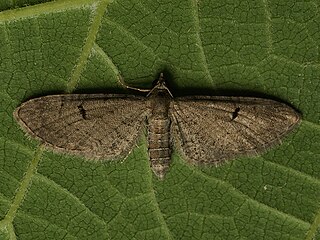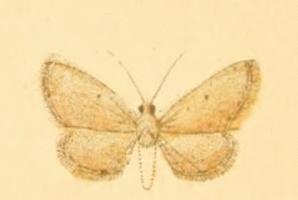
The tawny speckled pug(Eupithecia icterata) is a moth of the family Geometridae. It is found throughout the Palearctic region, the Near East and North Africa.

Eupithecia linariata, the toadflax pug, is a moth of the family Geometridae. The species can be found in Europe and from Anatolia to Tajikistan and Iran.

Eupithecia valerianata, the valerian pug, is a moth of the family Geometridae. The species was first described by Jacob Hübner in 1813. It is found from Great Britain, through central Europe to western Russia, Belarus and northern Iran.

Eupithecia breviculata is a moth of the family Geometridae. It is found in the Mediterranean region, Switzerland, Hungary, the Near East and North Africa. It is also found in Iran and Turkmenistan.

Eupithecia distinctaria, the thyme pug, is a moth of the family Geometridae. It is found throughout Europe. It is also found in Iran.
Eupithecia obtinens is a moth in the family Geometridae. It is found in Afghanistan and Iran.
Eupithecia parallelaria is a moth in the family Geometridae. It is found in Turkmenistan, Iran, eastern Afghanistan and Kashmir.
Eupithecia xanthomixta is a moth in the family Geometridae. It is found in Afghanistan and Iran.

Eupithecia silenicolata is a moth in the family Geometridae. It is found from southern Europe and Morocco to western Asia, Iran and Pakistan. In the north, the range extends to southern Switzerland, Austria and northern Italy.

Eupithecia extraversaria is a moth in the family Geometridae. It is found in most of Europe, except Fennoscandia, Estonia, northern Russia, Great Britain and Ireland. It is also found in Iran.

Eupithecia fuscicostata is a moth in the family Geometridae. It is found in Romania, North Macedonia and Greece, as well as the Near East and Iran.
Eupithecia gratiosata is a moth in the family Geometridae. It is found in France, the Iberian Peninsula, Italy, the Balkan Peninsula, Ukraine, Poland, Russia, Turkmenistan, Kazakhstan, the Near East and Iran.
Eupithecia limbata is a moth in the family Geometridae. It is found in Italy, France, Slovenia, North Macedonia, Greece and Bulgaria. It is also found in Iran.

Eupithecia sutiliata is a moth in the family Geometridae. It is found in south-eastern Russia and Mount Chelmos in Greece. It is also found in Iran.
Eupithecia tenellata is a moth in the family Geometridae. It is found in North Africa, Iran and the Arabian Peninsula.
Eupithecia aradjouna is a moth in the family Geometridae. It is found in Iran.
Eupithecia opistographata is a moth in the family Geometridae. It is found in Turkmenistan, Iran, Pakistan and China.
Eupithecia scortillata is a moth in the family Geometridae. It is found in Iran and Kyrgyzstan.
Eupithecia prouti is a moth in the family Geometridae. It is found in Iran.
Eupithecia accurata is a moth in the family Geometridae. It is found in Iran.






